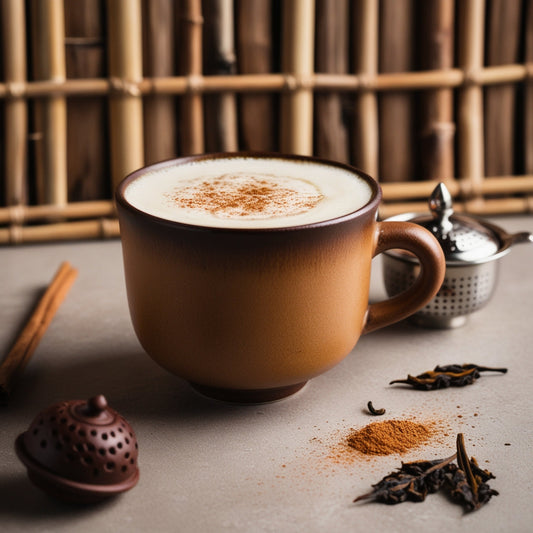Table of Contents
- Introduction
- Historical and Geographical Origins
- Specific Regions Within Yunnan
- Quality and Authenticity
- Cultural and Historical Significance of Pu-erh Tea
- Practical Advice for Consumers
- Conclusion
Introduction
Have you ever wondered where your favorite Pu-erh tea comes from? Curious about the story behind this unique tea? Want to know what makes it so special? You’re in the right place. In this article, we’ll uncover:
- The exact origins of Pu-erh tea
- Key regions in China where it’s produced
- Tips for identifying authentic Pu-erh tea
Let’s dive in and explore the rich history and geographical roots of Pu-erh tea.
Historical and Geographical Origins
Pu-erh tea comes only from China, specifically from the lush and diverse Yunnan Province. The climate and geography of this region are perfect for growing tea leaves with the unique characteristics of Pu-erh tea. Pu-erh tea has a history that goes back over a thousand years, deeply connected with ancient Chinese tea culture.
Moreover, the production of Pu-erh tea is centered in several key regions within Yunnan, each contributing to the tea’s unique flavors and qualities. The most notable areas include Xishuangbanna, Pu'er City and Lincang. These regions are known for producing high-quality Pu-erh tea, loved by tea enthusiasts worldwide.
Explore more about Yunnan Province and its significance in tea production.

Where Pu-erh Tea is from in Yunnan
Xishuangbanna: Xishuangbanna is famous for its rich biodiversity as well as ethnic diversity, both of which influence its tea culture. The area is home to ancient tea forests where some of the oldest tea trees in the world can be found. These trees produce leaves that are highly prized for their depth of flavor and potential for aging.
Pu'er City: As the namesake, Pu'er City plays a crucial role in its production. This region offers a wide range of Pu-erh, each with distinct characteristics. The city has a long history of tea trading. Hence, making it a central hub for authentic Pu-erh tea.
Lincang: Lincang is known for its ancient tea trees, some of which are over a thousand years old. Additionally, the tea from this region is noted for its robust flavor and unique aroma, making it a favorite among Pu-erh enthusiasts. Lincang’s high-altitude plantations provide ideal growing conditions for high-quality tea leaves.
Understanding these regions helps in appreciating the diversity and richness of Pu-erh tea. Each area contributes to the tea’s unique profile, influenced by local climate, soil, and traditional processing methods.
Learn more about the unique regions of Yunnan and their tea traditions.
Quality and Authenticity of Pu-erh Tea
The origin of Pu-erh tea significantly impacts its quality and authenticity. This Authentic tea must come from Yunnan Province, and understanding its specific region can help you gauge its quality. Here are some tips to help you identify genuine Pu-erh tea:
- Certification: Look for official certifications that verify the tea’s origin.
- Packaging: Authentic Pu-erh tea often includes information about its region and producer.
- Aroma and Taste: Genuine Pu-erh has a distinctive, complex aroma and flavor profile that reflects its regional characteristics.
Purchasing Pu-erh tea from reputable sources ensures you’re getting authentic and high-quality tea. For a reliable selection of genuine Pu-erh tea, visit Puerh Craft, where we offer a curated collection sourced directly from Yunnan.
By focusing on the specific pain points of those curious about Pu-erh tea’s origins, this article provides clear, relevant information that enriches the reader’s knowledge and aids in making informed choices.
Cultural and Historical Significance of Pu-erh Tea
Pu-erh tea is more than just a beverage; it’s a significant part of Chinese culture and history. The ancient Tea Horse Road played a vital role in the distribution of Pu-erh tea, connecting Yunnan with other parts of China and beyond. This historic trade route helped spread the popularity of Pu-erh tea, making it a valuable commodity.
Traditional processing methods, passed down through generations, are still used today to produce Pu-erh tea. These methods involve precise steps such as withering, rolling, fermentation, and aging. Each region has its unique techniques that add to the diversity of Pu-erh tea’s flavors.

Practical Advice for Consumers
Buying Guide: When purchasing Pu-erh tea, it’s important to buy from reputable sources to ensure authenticity and quality. Look for sellers who provide detailed information about the tea’s origin, age, and processing methods. You can find a trusted selection of authentic Pu-erh tea at Puerh Craft.
Storage and Aging: Pu-erh tea improves with age, developing deeper and more complex flavors over time. To store Pu-erh tea properly, keep it in a cool, dry place away from strong odors. Use breathable packaging, such as paper or clay jars, to allow the tea to age naturally. Proper storage conditions will enhance the tea’s aging process and maintain its quality.
Tasting Notes: The flavor profile of Pu-erh tea varies depending on its region and age. Young Pu-erh teas are often bold and astringent, with earthy and floral notes. As the tea ages, it mellows and develops richer, more complex flavors such as woody, fruity, and even sweet notes. Sampling teas from different regions can help you discover your preferred taste.
Discover more about tasting notes and the aging process of Pu-erh tea.
Conclusion
Understanding where Pu-erh tea comes from adds a deeper appreciation for this unique and ancient beverage. Knowing the specific regions and their characteristics can help you identify high-quality, authentic Pu-erh tea. Whether you are new to Pu-erh tea or a seasoned enthusiast, exploring the rich history and diverse flavors of this tea is a rewarding experience.
To explore a curated selection of authentic Pu-erh teas, visit Puerh Craft. Here, you’ll find teas sourced directly from Yunnan, ensuring the highest quality and authenticity.
By focusing on the origins, quality, and cultural significance of Pu-erh tea, this article aims to enrich your understanding and enhance your tea-drinking experience.
Q&A Section
Q1: What makes Pu-erh tea different from other types of tea?
Pu-erh tea is unique due to its fermentation process and aging potential. Unlike other teas, Pu-erh improves with age, developing deeper and more complex flavors. It also has a distinct, earthy taste that sets it apart from other teas.
Q2: Why is Yunnan Province the exclusive origin of Pu-erh tea?
Yunnan Province offers the ideal climate, soil, and altitude for growing the tea leaves used in Pu-erh tea. The region's long history of tea cultivation and traditional processing methods also contribute to the unique characteristics of Pu-erh tea.
Q3: How can I tell if Pu-erh tea is authentic?
To identify authentic Pu-erh tea, look for certifications, check the packaging for information about the tea’s region and producer, and pay attention to the aroma and taste. Authentic Pu-erh tea will have a distinctive, complex flavor profile that reflects its regional characteristics.
Q4: What are the health benefits of Pu-erh tea?
Pu-erh tea is known for its potential health benefits, including aiding digestion, reducing cholesterol levels, and promoting weight loss. It also contains antioxidants that help protect the body from free radicals.
Q&A Section 2
Q5: How should I store Pu-erh tea?
Store Pu-erh tea in a cool, dry place away from strong odors. Use breathable packaging, such as paper or clay jars, to allow the tea to age naturally. Proper storage conditions will enhance the tea’s aging process and maintain its quality.
Q6: Can I drink Pu-erh tea daily?
Yes, you can drink Pu-erh tea daily. It is a low-caffeine tea that can be enjoyed multiple times a day. Drinking Pu-erh tea regularly may contribute to its potential health benefits.
Q7: What is the best way to brew Pu-erh tea?
To brew Pu-erh tea, rinse the tea leaves with hot water first to "wake them up." Then, steep the leaves in hot water (around 95°C or 203°F) for 3-5 minutes. Adjust the steeping time and temperature according to your taste preference.
Q8: Where can I buy authentic Pu-erh tea?
For a reliable selection of genuine Pu-erh tea, visit Puerh Craft. We offer a curated collection of high-quality Pu-erh teas sourced directly from Yunnan Province.






